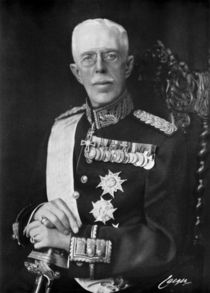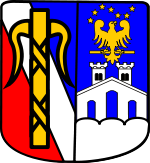Gustaf V of Sweden
| Gustaf V | |
|---|---|
| King of Sweden | |
 |
|
| Reign | 8 December 1907 - 29 October 1950 (42 years, 325 days) |
| Predecessor | Oscar II |
| Successor | Gustaf VI Adolf |
| Spouse | Victoria of Baden |
| Issue | |
| Gustaf VI Adolf Prince Vilhelm, Duke of Södermanland Prince Erik, Duke of Västmanland |
|
| Full name | |
| Oscar Gustaf Adolf | |
| Father | Oscar II |
| Mother | Sofia of Nassau |
| Born | 16 June 1858 Drottningholm Palace |
| Died | 29 October 1950 (aged 92) Drottningholm Palace |
| Burial | Riddarholmen Church |
Gustaf V (Oscar Gustaf Adolf 16 June 1858 – 29 October 1950) was King of Sweden from 1907. He was the eldest son of King Oscar II of Sweden and Sophia of Nassau, a half-sister of Adolphe I, Grand Duke of Luxembourg. Dying at age 92, he holds the record of being the oldest monarch of Sweden and the second-longest reigning monarch of Sweden (after Magnus IV).
Contents |
Early life
Gustaf V was born in Drottningholm Palace in Ekerö, Stockholm County and at birth was created Duke of Värmland. On 8 December 1907, he succeeded his father to the Swedish throne, which had been separated from the Norwegian throne two years earlier.
On 20 September 1881 he married Princess Victoria of Baden in Karlsruhe, Germany. She was the granddaughter of Princess Sophie of Sweden, and her marriage to Gustaf V united, by a real blood link (and not only so-called adoption), the reigning Bernadotte dynasty with the former royal house of Holstein-Gottorp.
Public life
Gustaf V was the last Swedish king to intervene directly in the politics of his country (in 1914 on the disputes over defence budgets). He was a conservative man, who did not approve of the democratic movement and the demands for workers' rights. Gustaf V was also the last Swedish King to be Supreme Commander of the Swedish Armed Forces (between 1907 and 1939).
Gustaf V was considered to have German sympathies during World War I. His political stance during the war was highly influenced by his wife, who felt a strong connection to her German homeland. On 18 December 1914, he sponsored a meeting with the other two Kings of Scandinavia to demonstrate unity within and between them. Another of Gustaf V's objectives with this three-King conference was to dispel suspicions that he wanted to bring Sweden into the war on Germany's side.
Nazi sympathies
Both the King and his grandson Prince Gustav Adolf, socialized with certain Nazi leaders before World War II, though arguably for diplomatic purposes. Gustaf V attempted to convince Hitler during a visit to Berlin to soften his persecution of the Jews, according to historian Jörgen Weibull. [1] He was also noted for appealing to the leader of Hungary to save its Jews "in the name of humanity." [2] At the behest of American President Franklin D. Roosevelt, Gustaf V appealed to Hitler for peace negotiations in 1938, "in the interest of peace". [3]
When Nazi Germany invaded the Soviet Union in October 1941, Gustaf V tried to write a private letter to Hitler thanking him for taking care of the "Bolshevik pest" and congratulating him on his "already achieved victories". [4] He was stopped from doing so by the Prime Minister Hansson. Nevertheless, the King sent the message to Hitler (through a telegram by the German embassy in Stockholm) behind the back of the Government.
The 1941 Threat of Abdication
According to Prime Minister Hansson the King had, during a private conversation, threatened to abdicate if the Government did not approve of the German request for permission to transfer one armed division – the Engelbrecht Division – through Swedish territory from northern Norway to northern Finland in June 1941. The accuracy of this claim is debated, and the King's stated intention (if he did in fact make this threat) was to avoid conflict with Germany. [5]
However, confirmation of the King's action is contained in German Foreign Policy documents captured at the end of the war. On 25 June 1941, the German Minister in Stockholm sent a "Most Urgent-Top Secret" message to Berlin in which he stated that the King had just informed him that the transit of German troops would be allowed. He added:
The King's words conveyed the joyful emotion he felt. He had lived through anxious days and had gone far in giving his personal support to the matter. He added confidentially that he had found it necessary to go so far as to mention his abdication. [6]
According to Ernst Wigforss, both Gustaf V and Prince Gustav Adolf attempted to persuade the Swedish Government to allow the Allies to transport troops through Sweden, though this was rejected by the Government because it was felt it would cause retributions from Germany. [7]
Personal life
|
Gustaf V was tall and thin. He wore pince-nez eyeglasses and sported a pointed mustache for most of his teen years.
Gustaf V was a devoted tennis player, appearing under the pseudonym Mr G. As a player and promoter of the sport, he was elected in to the International Tennis Hall of Fame in 1980. The King learned the sport during a visit in Britain in 1876 and founded Sweden's first tennis club on his return home. In 1936 he founded the King's Club. During his reign, Gustaf was often seen playing on the Riviera. On a visit to Berlin, Gustaf went straight from a meeting with Hitler to a tennis match with the Jewish player Daniel Prenn. [8] During World War II, he interceded to obtain better treatment for Davis Cup stars Jean Borotra of France and Gottfried von Cramm of Germany, who had been imprisoned by the German Government.
Homosexuality
Allegations of a homosexual affair made the Court pay Kurt Haijby at least 170,000 crowns. [9] This later led to the Haijby affair. No other evidence has ever been presented to support the allegations.
Styles and titles
Gustaf V was the 1,062nd Knight of the Order of the Golden Fleece in Spain, the 828th Knight of the Order of the Garter in 1905 and the 216th Grand Cross of the Order of the Tower and Sword.
Death
King Gustaf V died in Stockholm in 1950.
Image gallery
 Portrait Crown Prince Gustav and Crown Princess Victoria in the early 1880s |
 Portrait Crown Prince Gustaf in his 20s |
Sweden.jpg) Gustaf wears the Coronet of the Crown Prince and royal robes for a Riksdag opening in 1893 |
 Gustaf V making his famous Courtyard Speech at Stockholm Palace in 1914 |
 Speaking with Hjalmar Branting around 1920 |
Prince Gustav Adolf, Hermann Göring and Gustaf V in Berlin 1939. |
 Gustaf V, Crown Prince Gustav Adolf and Prince Bertil published in 1943 |
 Gustaf V accepting flowers |
Issue
| Name | Birth | Death | Notes |
|---|---|---|---|
| King Gustaf VI Adolf of Sweden | 11 November 1882 | 15 September 1973 | married 1) Princess Margaret of Connaught (1882-1920), had issue (four sons, one daughter) , married 2) Lady Louise Mountbatten (1889-1965), had issue (a stillborn daughter) |
| Prince Vilhelm of Sweden, Duke of Södermanland | 17 June 1884 | 5 June 1965 | married Grand Duchess Maria Pavlovna of Russia (1890-1958), had issue |
| Prince Erik of Sweden, Duke of Västmanland | 20 April 1889 | 20 September 1918 | died unmarried of the Spanish Flu, no issue |
Ancestors
| Ancestors of Gustaf V of Sweden | ||||||||||||||||||||||||||||||||||||||||||||||||||||||||||||||||||||||||||||||||||||||||||||||||||||||||||||||||||||||||||||||||||||||||||||||||||||||||||||||||||||||||||||||||||||||||||||||||||||||||||||||||||||||||||||||||||||||||||||||||||||||||||||||||||||||||||||||||||||||||||||||||||||||||||||||||||||||||||||||||||||||||||||||||||||||||||||||||||||||||||||||||||||||||||||||||||||||||||||||||||||||||||||||||||||||||||||||||||||||||||||||||||||||||||||||||||||||||||||||||||||||||||||||||||||||||||||||||||||||||||||||||||||||||||||||||||
|---|---|---|---|---|---|---|---|---|---|---|---|---|---|---|---|---|---|---|---|---|---|---|---|---|---|---|---|---|---|---|---|---|---|---|---|---|---|---|---|---|---|---|---|---|---|---|---|---|---|---|---|---|---|---|---|---|---|---|---|---|---|---|---|---|---|---|---|---|---|---|---|---|---|---|---|---|---|---|---|---|---|---|---|---|---|---|---|---|---|---|---|---|---|---|---|---|---|---|---|---|---|---|---|---|---|---|---|---|---|---|---|---|---|---|---|---|---|---|---|---|---|---|---|---|---|---|---|---|---|---|---|---|---|---|---|---|---|---|---|---|---|---|---|---|---|---|---|---|---|---|---|---|---|---|---|---|---|---|---|---|---|---|---|---|---|---|---|---|---|---|---|---|---|---|---|---|---|---|---|---|---|---|---|---|---|---|---|---|---|---|---|---|---|---|---|---|---|---|---|---|---|---|---|---|---|---|---|---|---|---|---|---|---|---|---|---|---|---|---|---|---|---|---|---|---|---|---|---|---|---|---|---|---|---|---|---|---|---|---|---|---|---|---|---|---|---|---|---|---|---|---|---|---|---|---|---|---|---|---|---|---|---|---|---|---|---|---|---|---|---|---|---|---|---|---|---|---|---|---|---|---|---|---|---|---|---|---|---|---|---|---|---|---|---|---|---|---|---|---|---|---|---|---|---|---|---|---|---|---|---|---|---|---|---|---|---|---|---|---|---|---|---|---|---|---|---|---|---|---|---|---|---|---|---|---|---|---|---|---|---|---|---|---|---|---|---|---|---|---|---|---|---|---|---|---|---|---|---|---|---|---|---|---|---|---|---|---|---|---|---|---|---|---|---|---|---|---|---|---|---|---|---|---|---|---|---|---|---|---|---|---|---|---|---|---|---|---|---|---|---|---|---|---|---|---|---|---|---|---|---|---|---|---|---|---|---|---|---|---|---|---|---|---|---|---|---|---|---|---|---|---|---|---|---|---|---|---|---|---|---|---|---|---|---|---|---|---|---|---|---|---|---|---|---|---|---|---|---|---|---|---|---|---|---|---|---|---|---|---|---|---|---|---|---|---|---|---|---|---|---|---|---|---|---|---|---|---|---|---|---|---|---|---|---|---|---|---|---|---|---|---|---|---|---|---|---|---|---|---|---|---|---|---|---|---|---|---|---|---|---|---|---|---|---|---|---|---|---|---|---|---|---|---|---|---|---|---|---|---|---|---|---|---|---|---|---|
|
||||||||||||||||||||||||||||||||||||||||||||||||||||||||||||||||||||||||||||||||||||||||||||||||||||||||||||||||||||||||||||||||||||||||||||||||||||||||||||||||||||||||||||||||||||||||||||||||||||||||||||||||||||||||||||||||||||||||||||||||||||||||||||||||||||||||||||||||||||||||||||||||||||||||||||||||||||||||||||||||||||||||||||||||||||||||||||||||||||||||||||||||||||||||||||||||||||||||||||||||||||||||||||||||||||||||||||||||||||||||||||||||||||||||||||||||||||||||||||||||||||||||||||||||||||||||||||||||||||||||||||||||||||||||||||||||||
External links
- Royal House of Sweden and Royal House of Norway
- Grand-Ducal House of Baden
- Gustaf V profile at the International Tennis Hall of Fame website
References
- ↑ Bernadottes on Sweden's Throne
- ↑ sv:Gustaf V#note-14
- ↑ sv:Gustaf V#note-16
- ↑ Dagens Nyheter 070729 [1]
- ↑ Hansson (Wahlbäck, Regeringen och kriget. Ur statsrådens dagböcker 1939-41) sv:Gustaf V#note-11
- ↑ Documents of German Foreign Policy 1918-1945 Series D Volume XIII The War Years 23 June 1941 – 11 December 1941, Published in UK by HMSO and in US By Government Printing Office.
- ↑ sv:Gustaf V#note-13
- ↑ sv:Gustaf V#note-18
- ↑ Heumann, Maths (1978) (in Swedish). Rättsaffärerna Kejne och Haijby. Stockholm: Norstedt. ISBN 91-1-787202-2.
- Opener of the 1912 Summer Olympics
|
Gustaf V
Born: 16 June 1858 Died: 29 October 1950 |
||
| Regnal titles | ||
|---|---|---|
| Preceded by Oscar II |
King of Sweden 1907-1950 |
Succeeded by Gustaf VI Adolf |
| Swedish royalty | ||
| Preceded by Oscar, Duke of Östergötland |
Heir to the Swedish throne 1872-1907 |
Succeeded by Gustaf Adolf, Duke of Skåne later became Gustaf VI Adolf |
| Preceded by Carl Adolf |
Duke of Värmland 1858-1907 |
Vacant
Title next held by
Carl Philip of Sweden |
|
|||||||||||||||||||||||||||||||||||||||||||||||||||||
|
|||||||||||||||||||||||||||||||||||||||||||||||||||||||
